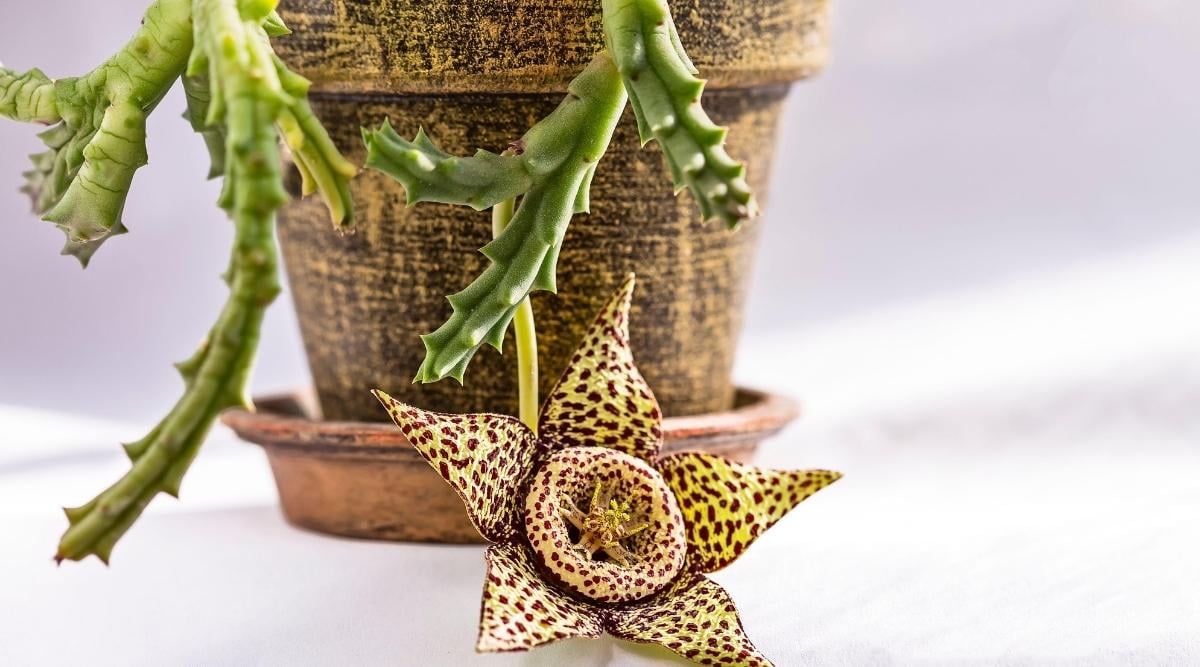Choosing the perfect succulent for your garden can be overwhelming due to the variety available. To help you decide, we’ve compiled a list of our favorite succulents with accompanying images and names.
Succulents are popular houseplants known for their resilience and low maintenance. They can thrive in various light conditions, making them ideal for beginners or those with busy schedules.
If you struggle to care for plants or are new to indoor gardening, a succulent could be the perfect match for you. Certain types can even flourish outdoors in warmer climates!
Below, we present a diverse selection of succulents that are perfect for indoor environments. Each succulent comes with a brief description, name, and images for reference. Let’s explore!
Afrikaans

Scientific Name: Odontophorus
- Plant Type: Perennial
- Plant Size: 3-8 inches
- Watering Needs: When the soil is completely dried out; Keep dry in winter
- Sun Exposure: Full sun
Afrikaans succulents feature broad, flat leaves that bend slightly upwards. They produce medium-sized flowers seasonally, usually in white or yellow hues.
These succulents thrive in full sun but can tolerate partial shade. To care for them, ensure minimal watering to prevent root rot.
Image Credit: Winfried Bruenken (Amrum) via Wikimedia Commons (Image Use Allowed With Attribution)
Agave

Scientific Name: Agavoideae
- Plant Type: Perennial
- Plant Size: 1 inch-8 feet
- Watering Needs: When the soil is completely dried out
- Sun Exposure: Full sun
Agave is a well-known succulent used for its syrup in cocktails and as a sugar substitute. These plants prefer warm, sunny locations where they can thrive.
With pointed leaves and symmetrical rosettes, Agave plants offer a striking appearance within a garden setting.
Aloe

Scientific Name: Aloe vera
- Plant Type: Perennial
- Plant Size: 1 inch-3 feet
- Watering Needs: When the top 1-2 inches of soil are dry
- Sun Exposure: Full sun
Aloe is renowned for its soothing properties on sunburns and rashes, thanks to its jelly-like leaf substance. It adds a vibrant green touch to any indoor space.
Provided with proper drainage and sunlight, Aloe plants can reach three feet in height. Avoid overwatering to maintain a healthy, thriving specimen.
Ant Plant

Scientific Name: Dischidia pectinoides
- Plant Type: Perennial
- Plant Size: 1-3 feet
- Watering Needs: When the top 1-2 inches of soil are dry
- Sun Exposure: Full sun
The Ant Plant may not resemble typical succulents due to its thin, loose leaves. This unique plant displays vine-like growth patterns, attaching to support structures with its aerial roots.
Not storing water as efficiently as some, succulents require extra care but remain quite resilient. The slender, drooping leaves and branches of these plants make them perfect for hanging pots, giving off an enchanting appearance reminiscent of a secret garden.
Astridia
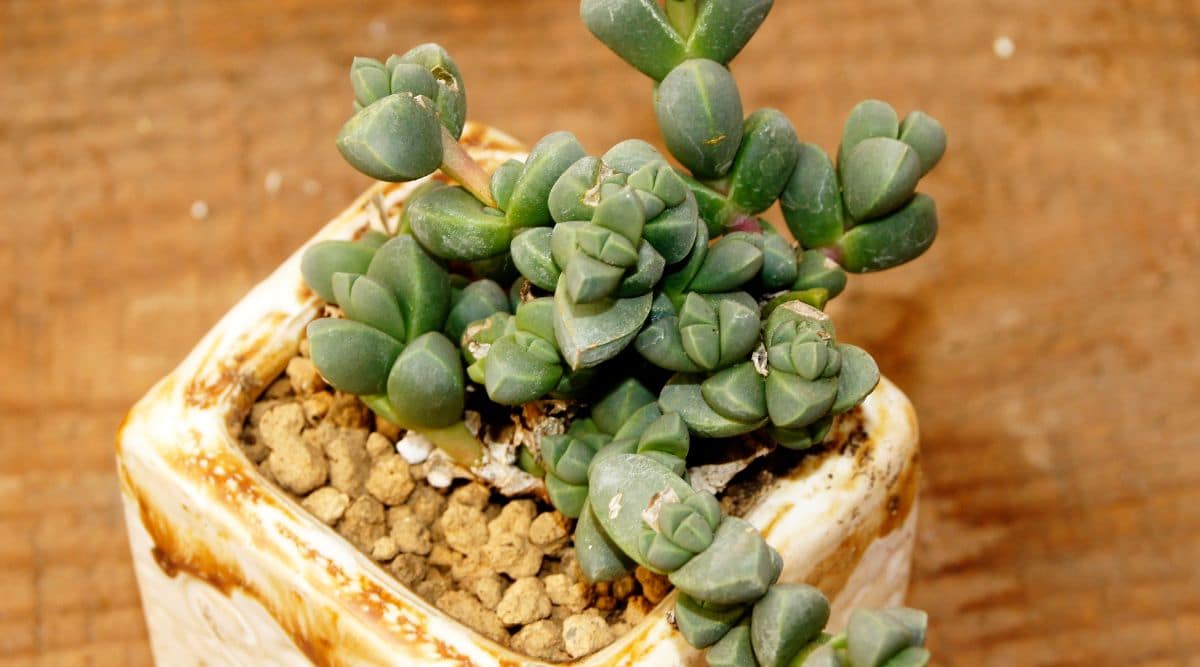
Scientific Name: Astridia velutina
- Plant Type: Perennial
- Plant Size: 8 inches
- Watering Needs: When soil is completely dried out
- Sun Exposure: Full sun
Considered a finicky succulent, Astridia demands more attention but rewards patience and care. It adorns itself with daisy-like flowers emerging from cactus-like leaves, embodying both delicate and robust characteristics.
Original Image Credit: Abu Shawka, CC0, via Wikimedia Commons
Astroworthia
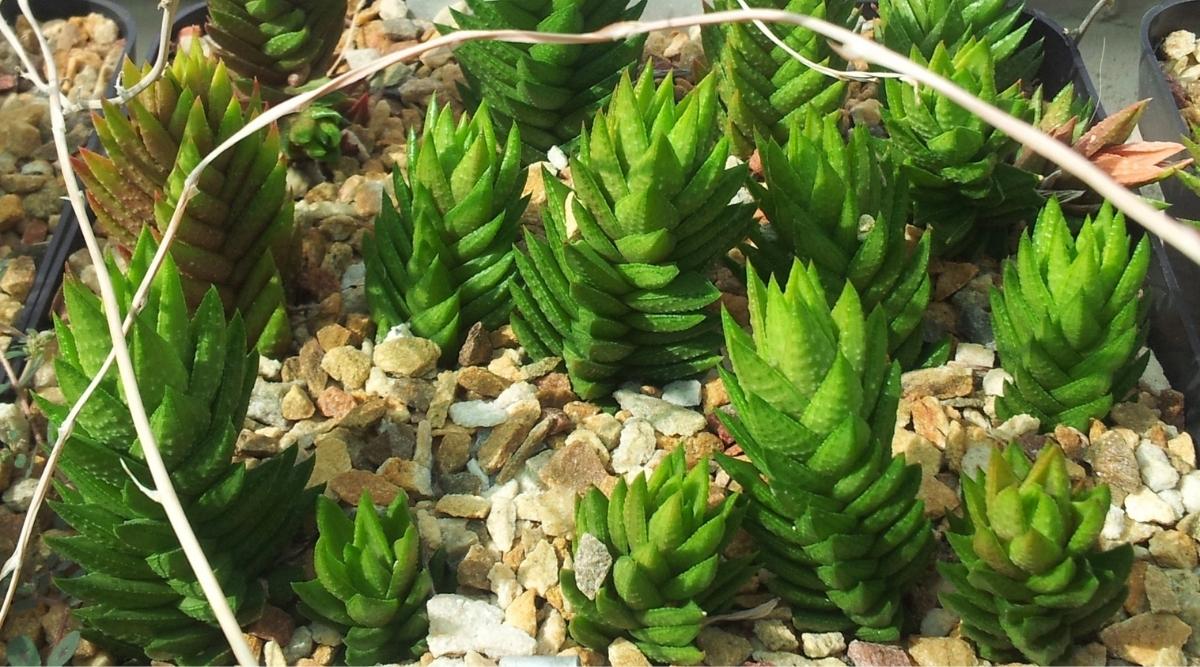
Scientific Name: Astroworthia bicarinata
- Plant Type: Perennial
- Plant Size: 6 inches-3 feet
- Watering Needs: When soil is completely dried out
- Sun Exposure: Full Sun
Astroworthia, an obscure succulent, features chunky green and red leaves with defensive notches. As they mature, these plants acquire a pleasing pink or red hue, perfect for enhancing your living space or garden path with their compact growth habit.
Avonia

Scientific Name: Avonia ustulata
- Plant Type: Perennial or annual
- Plant Size: 1-3 inches
- Watering Needs: When the top 1-2 inches of soil are dry; Keep dry in the winter
- Sun Exposure: Full sun
Avonia, though considered challenging, can thrive with proper care in dry and warm conditions. It exhibits resilience to moisture but may not be visually appealing to all due to its unique leaf shape likened to worms emerging from the soil.
Babies’ Toes
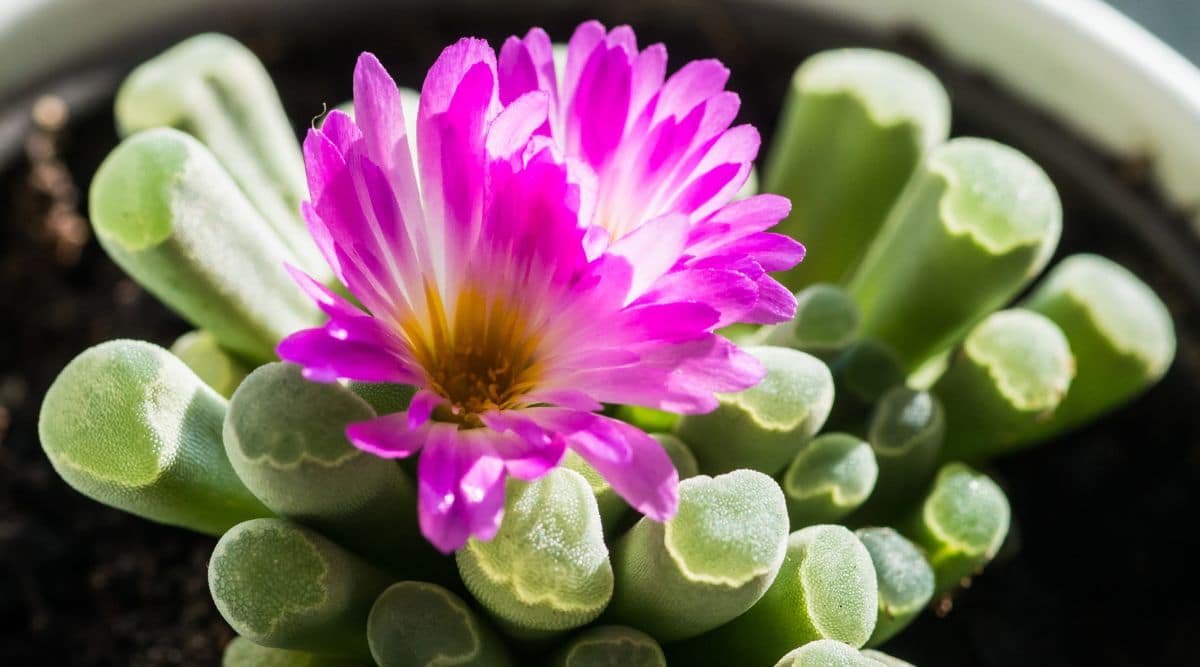
Scientific Name: Fenestraria
- Plant Type: Perennial
- Plant Size: 3-6 inches
- Watering Needs: When the top 1-2 inches are dry
- Sun Exposure: Full sun
Babies’ Toes, with its chubby stem and leaf growth reminiscent of tiny toes, require ample sunlight to thrive but are sensitive to cold and shade. Ideal for indoor upkeep in regions below zone 9, these succulents wither rapidly without adequate sunshine.
Braunsia

Scientific Name: Braunsia maximiliani
- Plant Type: Perennial
- Plant Size: 5-10 inches
- Watering Needs: Maintain soil moisture by watering when the top 1-2 inches are dry; Keep soil dry in winter
- Sun Exposure: Full sun
Displaying a chunky and triangular shape, the leaves of the Braunsia plant are visually striking. Occasionally, this plant produces charming purple blossoms, enhancing the visual appeal of any garden or living space.
Even without blooms, the dense foliage elegantly cascades from containers or grounds, resembling a fusion of ivy and cactus. For enthusiasts of unique succulents, the Braunsia is a must-have addition to your collection.
Image Credit: Dwergenpaartje, via Wikimedia Commons (Image Use Allowed With Attribution)
Bunny Succulent
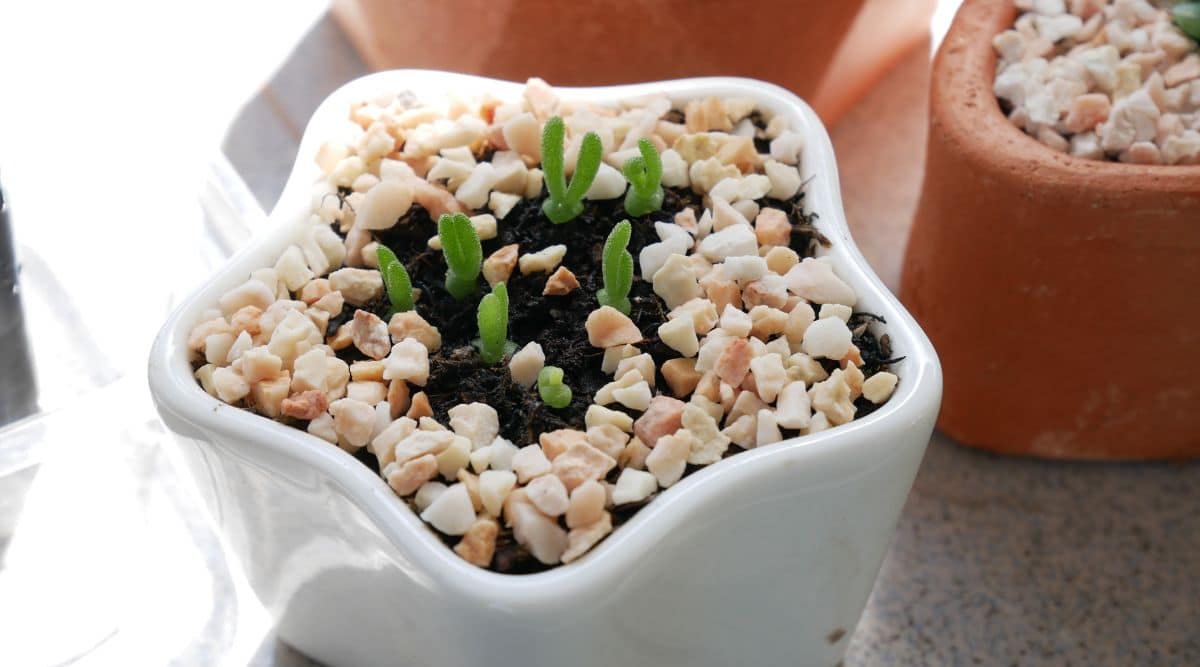
Scientific Name: Monilaria
- Plant Type: Perennial
- Plant Size: 1-6 inches
- Watering Needs: Ensure soil moisture by watering when the top 1-2 inches are dry; Allow soil to completely dry in winter
- Sun Exposure: Full sun to partial sun
Known as the string of pearls, the bunny succulent is a slow-growing, visually captivating plant. Its small bulbous leaves arranged along the branches create a delightful resemblance to strings of pearls cascading from a pot.
Despite its diminutive size, this resilient succulent perseveres through harsh conditions like droughts and frosts, displaying year after year of growth.
Chandelier Plant
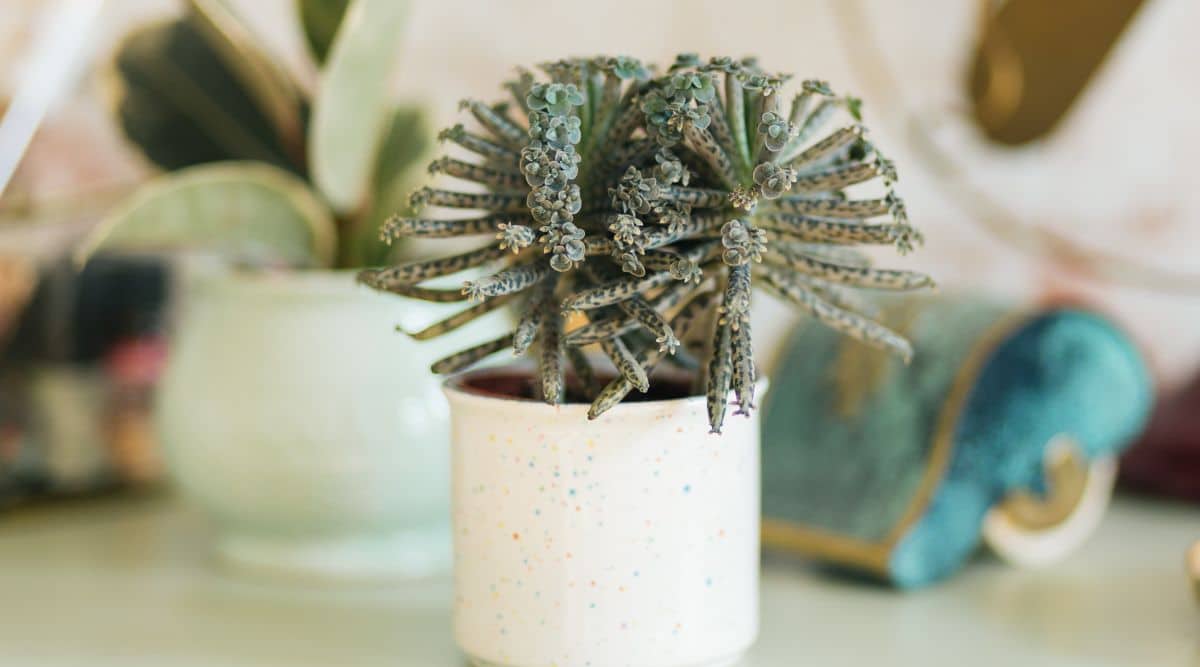
Scientific Name: Kalanchoe
- Plant Type: Perennial
- Plant Size: 8-12 inches tall
- Watering Needs: Maintain soil moisture by watering when the top 1-2 inches are dry
- Sun Exposure: Partial sun
The chandelier plant defies typical succulent appearances with its slender, glossy leaves and vibrant miniature flowers in an array of colors. While this perennial plant blooms annually, many treat it as an annual once the blossoms wane.
With a penchant for heat, these succulents prefer filtered light to prevent leaf scorching, ensuring optimal growth conditions.
Chinese Dunce Cap

Scientific Name: Orostachys japonica
- Plant Type: Biennial
- Plant Size: 0.5-2 inches
- Watering Needs: Ensure soil moisture by watering when the top 1-2 inches are dry
- Sun Exposure: Full sun to partial sun
Exuding a delicate and ethereal aura, the Chinese Dunce Cap plant features green leaves overlaid with a soft white hue, presenting an icy and refined aesthetic.
A standout in any plant collection, its unique appearance deviates from the traditional greenery of typical houseplants. The circular, thick leaves overlap concentrically to mimic a cactus blossom, with each resembling a dunce cap—an amusing moniker for this elegant succulent. Adaptable to colder environments, it thrives where many other succulents struggle.
Chinese Jade
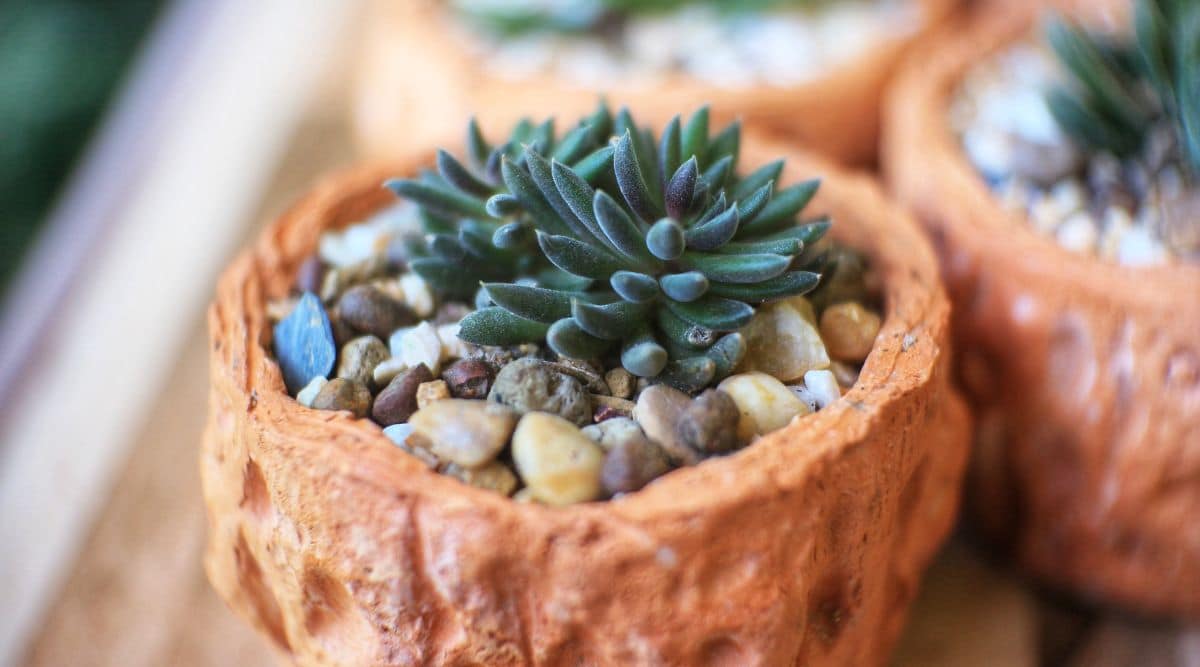
Scientific Name: Sinocrassula yunnanensis
- Plant Type: Perennial
- Plant Size: 2-4 inches
- Watering
- When the top 1-2 inches of soil are dry
Chinese jade, a tiny succulent, is recognized for its soft green color and origins. It forms spiky spheres resembling a pile of sea urchins with chunky spikes.
Many mature Chinese jade plants change from soft jade to deep forest green or even dark black.
Chiovenda
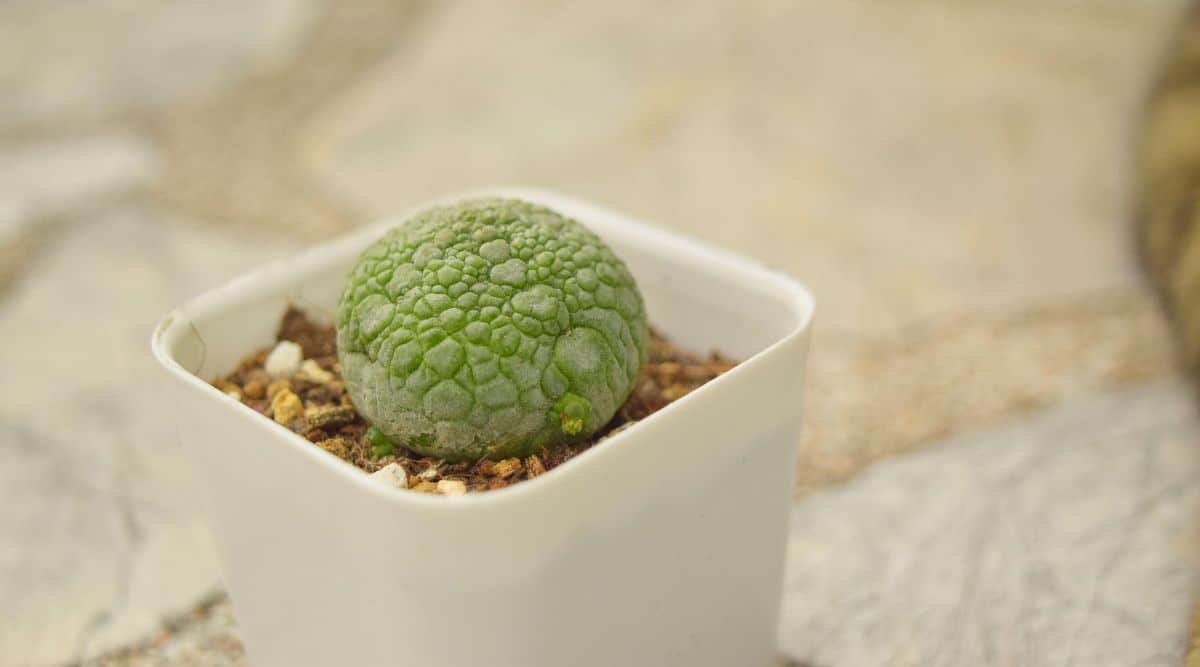
Chiovenda requires bright diffused light with slight shading from direct sunlight on hot summer days. Scientific Name: Pseudolithos
- Plant Type: Perennial
- Plant Size: 2-3 inches
- Water when the top 1-2 inches of soil are dry; Keep dry in winter
- Sun Exposure: Full sun
The Chiovenda succulent has a unique appearance with its odd shape resembling fake stones. It lacks leaves and appears as a plant mass.
Occasionally, it produces red star-shaped flowers clustered on its base, giving it an otherworldly look. Despite its resilience in harsh climates, it dislikes low temperatures.
Concrete Leaf
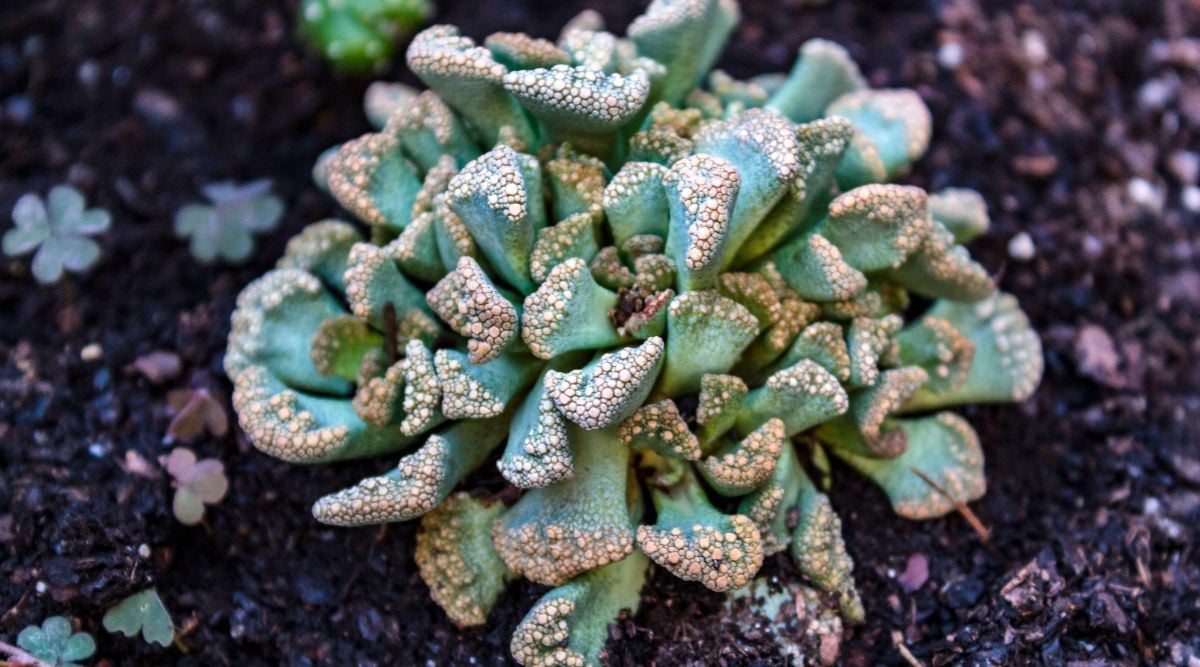
The unique Concrete Leaf succulent prefers loose and very light soil. Scientific Name: Titanopsis calcarea
- Plant Type: Perennial
- Plant Size: 1-3 inches
- Water when the soil is completely dried out; Keep dry in winter
- Sun Exposure: Full sun
The Concrete Leaf, also known as the Sheep’s Tongue or the Carpet Leaf, features rough leaves resembling concrete but are softer to the touch. Its bluish-green or light gray chunky wavy leaves produce small yellow flowers occasionally.
Its unconventional appearance may give the impression of wilting, but the grayish hue is its natural look. While it can thrive in tough conditions, it thrives best in hot weather and sunlight.
Coral Plant
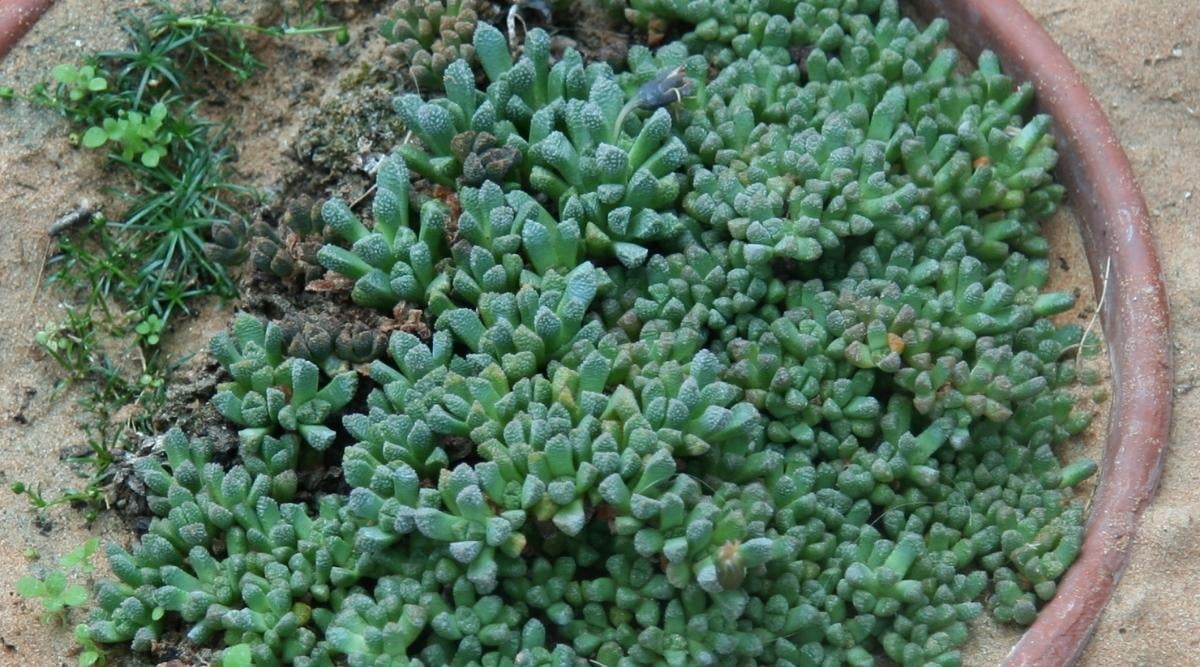
The Coral Plant grows up to about 1 inch in height. Scientific Name: Neohenricia
- Plant Type: Perennial
- Plant Size: 0.5-1 inch
- Water when the top 1-2 inches of soil are dry
- Sun Exposure: Full sun to partial shade
The Coral Plant, unlike most succulents, appreciates cooler weather and intermittent shade. It’s recommended to provide full sun in winter and partial shade in summer.
This succulent demands a bit more attention than others but remains low maintenance. It grows small thick sprouts of green leaves and, despite its unimpressive appearance, is quite hardy.
Image Credit: Michael Wolf, via Wikimedia Commons (Image Use Allowed With Attribution)
Deltoid-leaved Dew Plant
Fairy Elephant’s Feet, a miniature succulent from the living stones group, showcases lovely pink flowers. Scientific Name: Frithia pulchra
- Overview: Fairy Elephant’s Feet is a perennial that grows up to 8 inches.
- Watering: Water only when the soil is fully dried out.
- Sun Needs: Requires full to partial sun exposure.
Admire the adorable Fairy Elephant’s Feet succulent with its chubby cactus leaves and occasional burst of pink or purple blooms.
Though resembling baby toes succulents, this plant surprises with its budding flowers. Its club-shaped leaves bring a unique touch to any plant collection; caring for it is easy – just give it plenty of sunlight like most succulents.
Hens and Chicks
Hens and Chicks, also known as Mexican snowball or white Mexican rose, features rounded, green leaves and blossoms with yellow-pink flowers. Scientific Name: Echeveria elegans
- Overview: Hens and Chicks is a perennial growing between 1-4 inches.
- Watering: Water when the top 1-2 inches of soil are dry.
- Sun Needs: Thrives in full to partial sun.
This type of Hens and Chicks, resembling an artichoke with plumper jade green leaves, clusters attractively, creating a rose-shaped appearance when viewed from above.
These succulents tend to cover the ground, growing no taller than a few inches, forming a beautiful landscape when multiple plants grow together.
Ice Plant
Ice Plants, adapting to dry conditions, grow on rocky surfaces and can endure extended droughts. Scientific Name: Corpuscularia
- Overview: Ice Plants are a type of perennial that reaches 8-12 inches.
- Watering: Only water when the top 1-2 inches of soil are dry.
- Sun Needs: Requires full sun exposure.
Contrary to its name, the Ice Plant won’t survive cold temperatures or frost but is generally low maintenance, thriving in suitable conditions.
Its blue-green, plump leaves and unique shape akin to ice cubes give it a distinct appearance, adding interest to any garden or collection.
Jade Plant
Jade Plants, adaptable and hardy, flourish in various environments. Scientific Name: Crassula ovata
- Overview: Jade Plants are perennials that can grow up to 3-6 feet tall.
- Watering: Water when the top 1-2 inches of soil are dry.
- Sun Needs: Prefers full sun exposure.
Jade Plants, part of the crassula genus, showcase small, oval leaves clustered on branches, lending a tree-like appearance when mature.
With proper care, these succulents can grow tall and robust, becoming a prominent feature in any space.
Juttadinteria
This short succulent, Juttadinteria, typically stays under 10 inches in height. Scientific Name: Juttadinteria suavissima
- Overview: Juttadinteria belongs to the perennial category and reaches about 4-10 inches in size.
- Watering: Water when the top 1-2 inches of soil are dry.
- Sun Exposure: Full sun
Presenting another stylish succulent option is the Juttadinteria, featuring cactus-like leaves and a striking central bloom. This low-growing succulent boasts woody roots that can give it a tree-like appearance if allowed to grow substantially.
The plant’s boat-shaped leaves form dense clusters, offering a full look without excessive bushiness. Admired for its aesthetic appeal, caring for the Juttadinteria is a breeze as long as it receives adequate sunlight. Remember, though, that these succulents have a slow growth rate, so patience is key!
Image Credit: Michael Wolf, CC BY-SA 3.0, via Wikimedia Commons (Image Use Allowed With Attribution)
Karoo Rose

Scientific Name: Lapidaria margaretae
- Plant Type: Perennial
- Plant Size: 1-3 inches
- Watering Needs: When the soil is completely dried out
- Sun Exposure: Full sun
The Karoo Rose is a petite succulent with a captivating appearance, growing in compact clusters of water-storing leaves. Resembling small triangular pebbles grouped together, this succulent offers a unique and plump look. Despite its diminutive size, it can surprise you with a lovely yellow flower emerging from the midst of its leaves when well-tended in direct sunlight.
Lampranthus
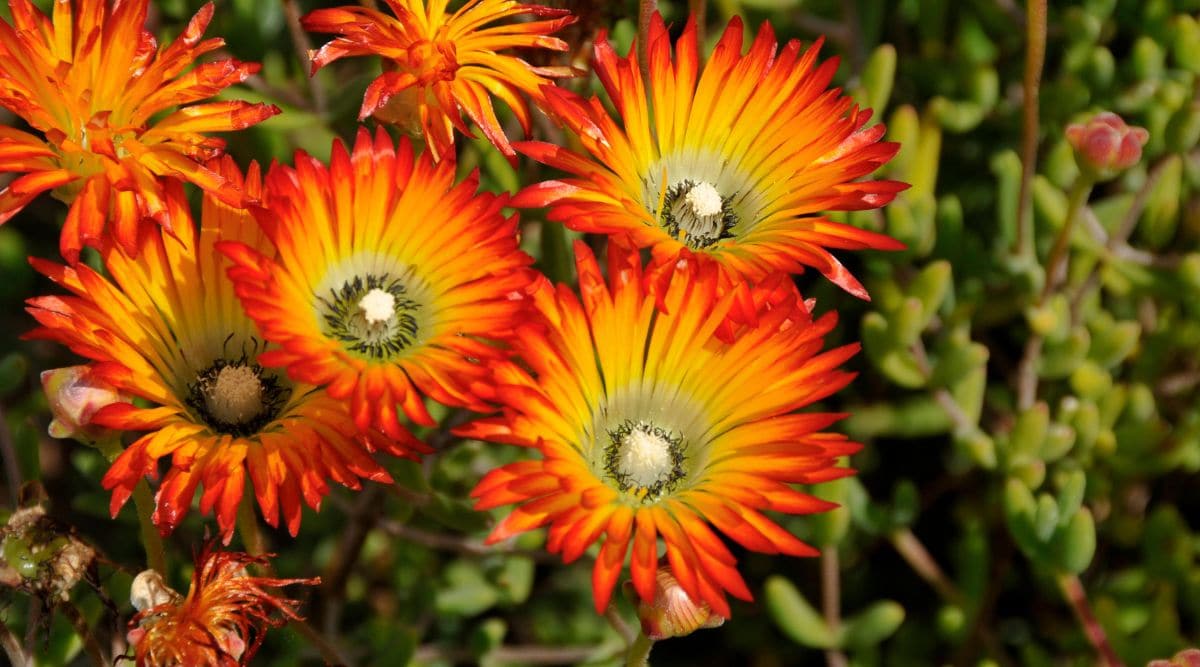
Scientific Name: Lampranthus bicolor
- Plant Type: Perennial
- Plant Size: 6-12 inches
- Watering Needs: When the top 1-2 inches of soil are dry
- Sun Exposure: Full sun
Lampranthus succulents are captivating and diverse, resembling ordinary flowers at a glance but revealing thick, water-filled stems and branches upon closer examination. Available in an array of delightful colors such as orange, purple, pink, blue, white, and yellow, these succulents offer a colorful and low-maintenance option for gardeners seeking vibrancy.
Tiny Treasure
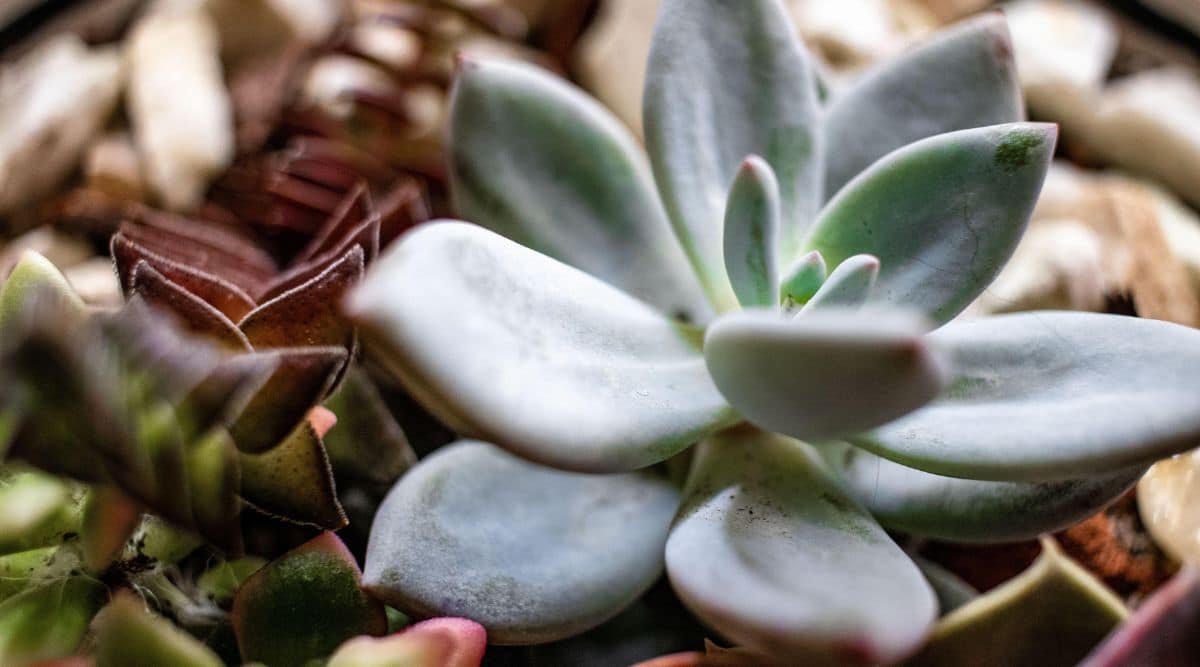
Scientific Name: Pachyveria haagei
- Type: Perennial Succulent
- Size: 3-7 inches
- Watering: When the top 1-2 inches of soil are dry
- Sun: Full sun to partial shade
In elegant and straightforward rosettes, the diminutive jewel succulent, also known as the jeweled crown, displays mint or pea green hues with thick cactus leaves that sprout upwards from the base.
These plants can develop a pinkish tint around the edges, and sometimes the entire plant transforms into a captivating pinkish-red shade for added visual interest. It’s a beloved succulent choice due to its commonality, although it necessitates ample warmth.
Eternally Thriving
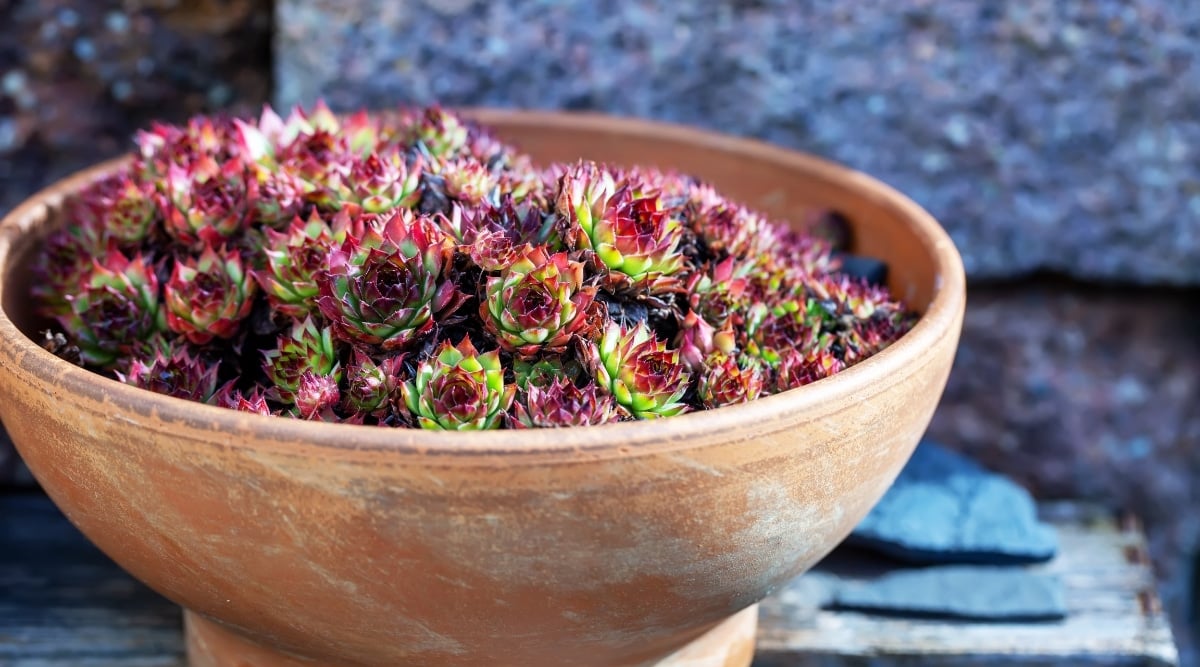
Scientific Name: Sempervivum
- Type: Perennial Succulent
- Size: 2-8 inches
- Watering: When the top 1-2 inches of soil are dry
- Sun Exposure: Full sun to partial shade
True to its name, the liveforever succulent is incredibly resilient and can thrive indefinitely. Flourishing in various hardiness zones, they are low-maintenance plants. Some variations of this succulent exhibit purple hues on their leaves, giving them a distinct appearance.
In their natural habitat, they typically form mats of rosettes close to the ground, a trait they retain when cultivated in home gardens. When potted, they tend to stay compact and do not spread extensively. These dense rosettes have sharp edges that should be handled carefully.
Fully dry before watering again
The macho mocha is a standout among succulents for its size, making a bold statement in any collection. While not the most vibrantly colored succulent, it often boasts a deep purple hue, complementing its typical brownish shade, hence the name mocha.
Under certain conditions, it can take on a rich dark red color. These hardy plants thrive in various conditions and can even withstand a frost if not exposed to prolonged cold.
Monanthes
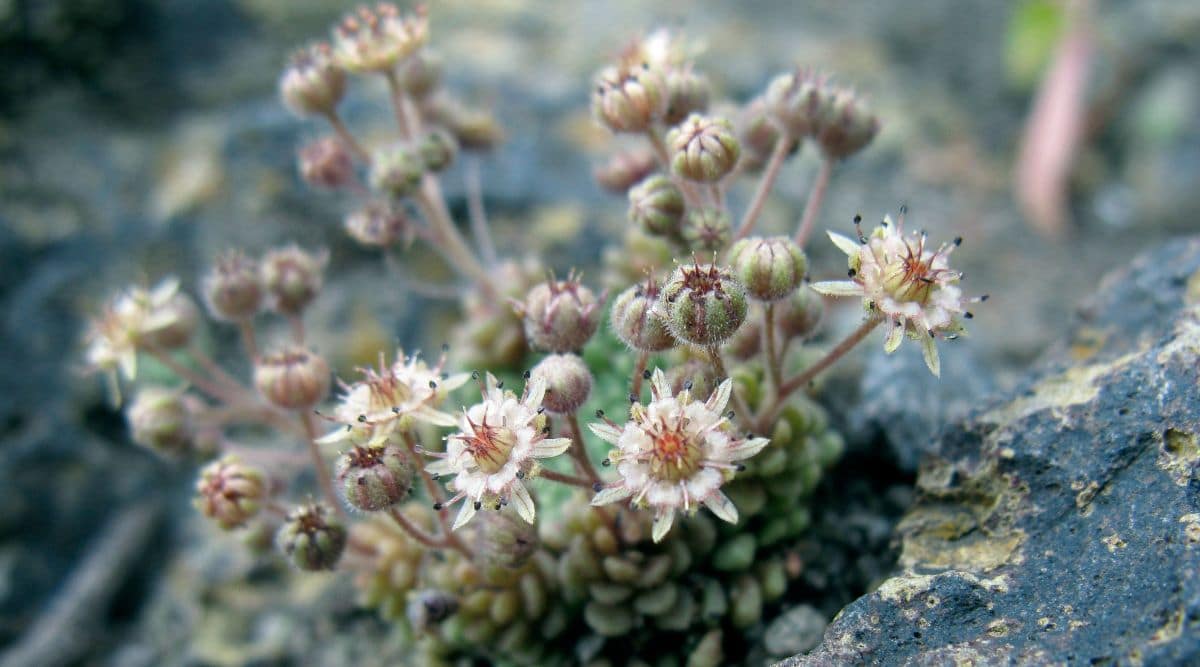
Scientific Name: Monanthes pallens
- Plant Type: Perennial
- Plant Size: 3-6 inches
- Watering Needs: Water when the top 1-2 inches of soil are dry
- Sun Exposure: Full sun
Monanthes is characterized by its leaves resembling intricate geometric fractals, enticing observers with their perfectly arranged grooves on rounded, stubby leaves that seem almost too precise to occur naturally.
Growing in small clumps, these plants are slow growers, not ideal for quick plant refreshes.
Navelwort
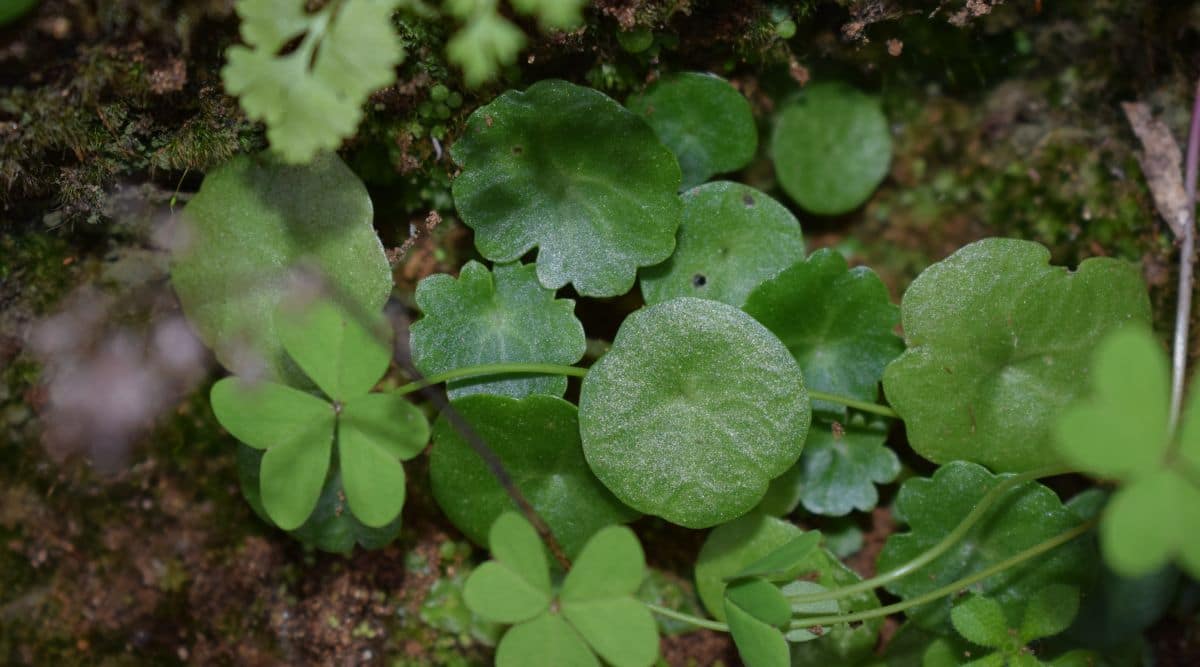
Scientific Name: Umbilicus rupestris
- Plant Type: Perennial
- Plant Size: 3-10 inches
- Watering Needs: Water when the top 1-2 inches of soil are dry
- Sun Exposure: Full sun to full shade
Known by quirky names like penny-pies or wall pennywort, Navelwort cascades down cliff walls, thriving in damp, shaded environments while also basking in the sun.
The leaves resemble lily pads with belly-button-like impressions in the center earning them the moniker navelworts. These plants can be challenging in arid climates, as they prefer high humidity.
Opalina
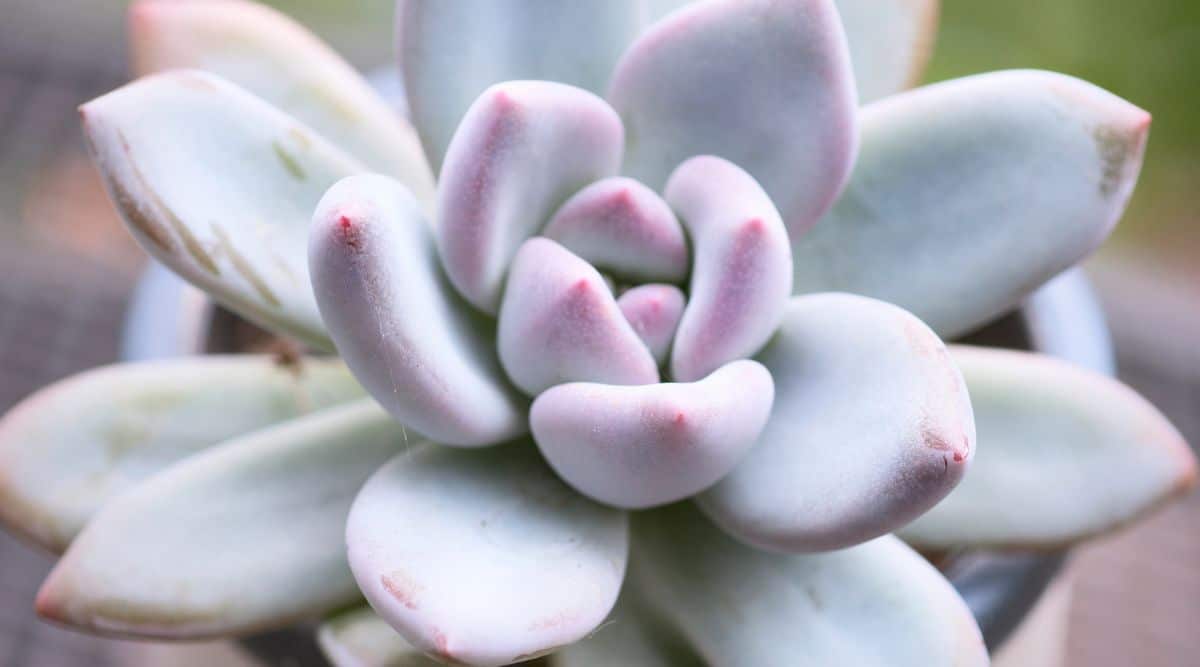
Scientific Name: Graptoveria
- Plant Type: Perennial
- Plant Size: 6-8 inches
- Watering Needs: Allow the soil to completely dry out before watering
- Sun Exposure: Full sun
Opalina, a charming succulent, transitions to a deep purple shade in maturity. This rare hybrid from Echeveria and Graptopetalum boasts sharp tear-drop leaves starting with a mint green color, eventually developing pink edges or a dusky purple hue in more mature specimens.
The thick, bud-surrounded leaves grow in concentric circles, storing ample water for survival, making full sun exposure its primary need.
Peperomia pellucida
- Classification: Perennial
- Dimensions: 6-18 inches
- Watering Requirements: Allow top 1-2 inches of soil to dry
- Sunlight Exposure: Full to partial sun
Thriving in warm, humid conditions, the plant is intolerant to cold temperatures and flourishes best in a damp atmosphere. Its succulent stems contrast with the thin, glossy leaves, often displaying bi-colored patterns with white or light green edges against a dark green backdrop.
Pig’s Ear
Cotyledon
- Classification: Perennial
- Dimensions: 1-4 feet
- Watering Requirements: Allow soil to completely dry out before rehydration
- Sunlight Exposure: Full sun to partial shade
Pig’s Ear succulent exhibits flat tear-shaped light green leaves that may transition to shades of pink or red as it matures, hence its colloquial name. When reaching a foot in height, the plant’s branches tend to cascade, making it an ideal hanging plant indoors.
Plover Eggs
Adromischus cooperi
- Classification: Perennial
- Dimensions: 2-6 inches
- Watering Requirements: Allow top 1-2 inches of soil to dry
- Sunlight Exposure: Full sun
Plover Eggs, a scarce succulent variety, appeals to enthusiasts of exotic flora. While slow-growing, this plant metamorphoses into a tree-like form as it matures, developing a diverse palette of powdery colors from green to brown to purple.
Prenia
Prenia pallens
- Classification: Perennial
- Dimensions: 2-4 inches
- Watering Requirements: Allow top 1-2 inches of soil to dry
- Sunlight Exposure: Full sun
Rapid growth characterizes Prenia, displaying gray-green leaves ranging from elongated to oblong. Daisy-like flowers in a soft pink to white or yellow hue bloom in summer, a common sight alongside South African roadsides.
Prince Albert Vygie
Ebracteola wilmaniae
- Classification: Perennial
- Dimensions: 2-3 inches
- Watering Requirements: Allow top 1-2 inches of soil to dry
- Sunlight Exposure: Full sun to partial sun
Possessing elongated leaves akin to aloe vera, Prince Albert Vygie presents daisy-like flowers in varying shades of white, purple, or pink, adding splashes of color to your garden. Well-suited to both dry and wet environments, this succulent thrives with ample sunlight exposure.
Classification: Perennial
Roselings, a member of the Commelin family, is an evergreen perennial herbaceous plant that thrives well in partial to full sun exposure. This charming plant adds a touch of elegance with its delicate appearance and compact size.
With its low maintenance requirements, Roselings make for a lovely addition to any indoor garden setting. Whether placed in a planter on a windowsill or as part of a terrarium, this plant will surely captivate onlookers with its dainty foliage and subtle grace.
String of Pearls
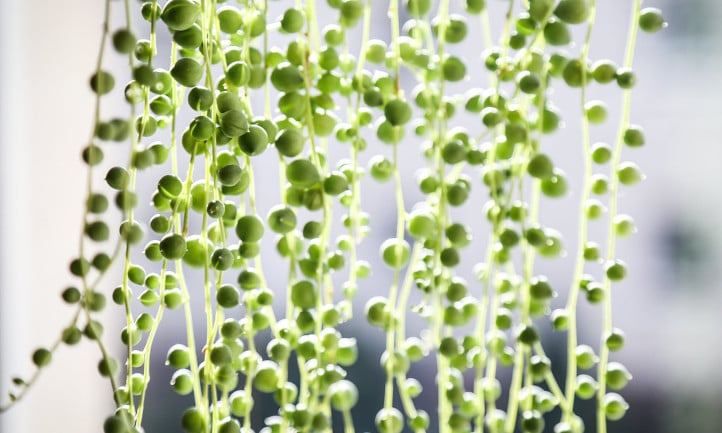
Scientific Name: Senecio rowleyanus
- Plant Type: Perennial
- Plant Size: 6-12 inches
- Watering Needs: Allow soil to dry out between waterings
- Sun Exposure: Bright indirect light to partial shade
String of Pearls, scientifically known as Senecio rowleyanus, showcases a unique trailing growth habit, making it an excellent choice for hanging planters or elevated shelves. Its distinct spherical foliage resembling tiny pearls adds a whimsical touch to any environment.
This perennial succulent is easy to propagate and care for, making it a popular choice among plant enthusiasts. With proper maintenance, the String of Pearls can thrive and cascade beautifully, enhancing the aesthetic appeal of any space.
- Type: Perennial
- Size: 4-12 inches
- Watering Needs: When the top 1-2 inches of soil are dry
- Sun Exposure: Full sun
Callisia, a unique succulent, may not resemble a typical cactus due to its distinct leaves. With a fern-like look, this low-growing plant is effortless to nurture and adds vibrancy to hanging pots or indoor spaces.
Showcasing tiny and charming leaves, it forms a slightly dense appearance that enriches your plant assortment with depth and fullness.
Sea Rocket
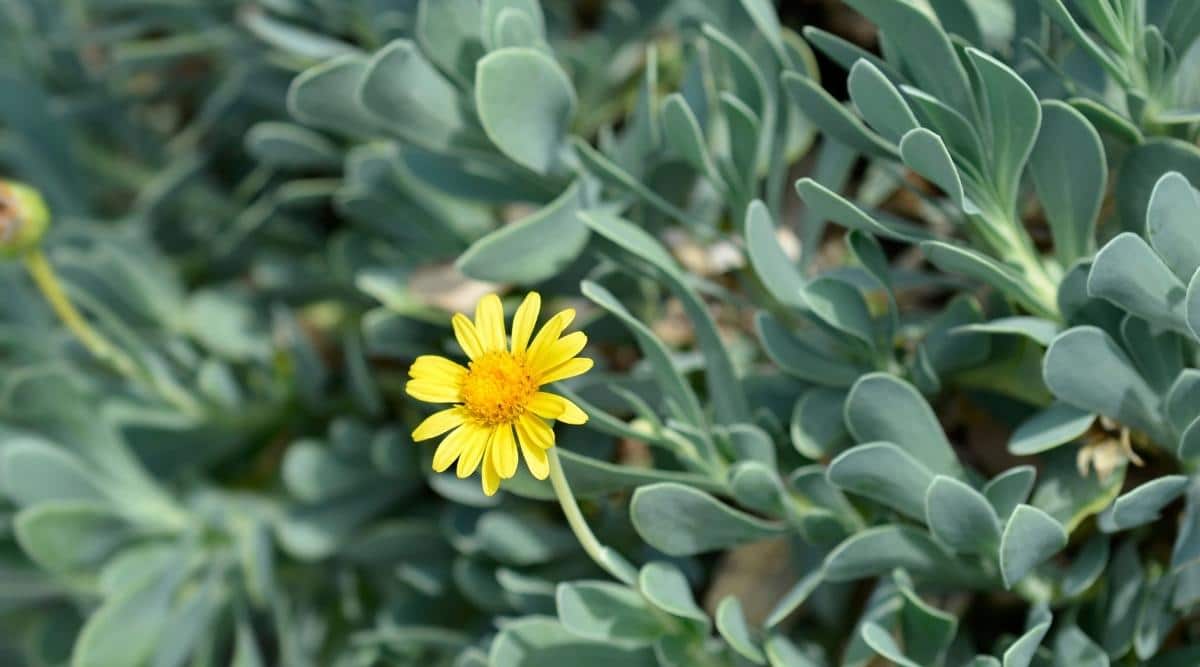
Scientific Name: Othonna
- Plant Type: Perennial
- Size: 3-4 inches
- Watering Needs: When the soil is completely dried out
- Sun Exposure: Full sun to partial shade
Sea Rocket, a succulent with fleshy properties, rapidly flourishes under favorable conditions. It features a woody texture near its roots, growing close to the ground and spreading horizontally rather than skyward.
The closely packed leaves, resembling miniature pickles, contribute to its adorable appeal. When in bloom, delicate yellow and orange flowers adorn this charming succulent.
Snake Plant

Scientific Name: Sansevieria trifasciata
- Plant Type: Perennials
- Size: 8 inches – 12 feet
- Watering Needs: When the soil is nearly dried out
- Sun Exposure: Full sun to partial shade
Although well-known, the snake plant’s status as a succulent is often overlooked. Known by several aliases, including Saint George’s sword and mother-in-law’s tongue, this plant grows upright and tall.
Its broad and slender leaves, reminiscent of a sword, explain one of its monikers. In ideal conditions, its size can be massive, but household varieties typically reach around a foot, quite substantial for a succulent.
Spiderwort

Scientific Name: Tradescantia
- Plant Type: Perennial
- Size: 5-10 inches
- Watering Needs: When the top 1-2 inches of soil are dry
- Sun Exposure: Indirect sunlight
The spiderwort, also known as the Wandering Jew, boasts a lush purple hue with long, slender leaves that deviate from typical succulent appearances.
Its leaves may be entirely purple, akin to red wine, or sport purple stripes along with muted green. Exposure to excessive direct sunlight, leading to a pinkish tint, indicates the need to relocate the plant away from the sun.
Silver Dollar Plant
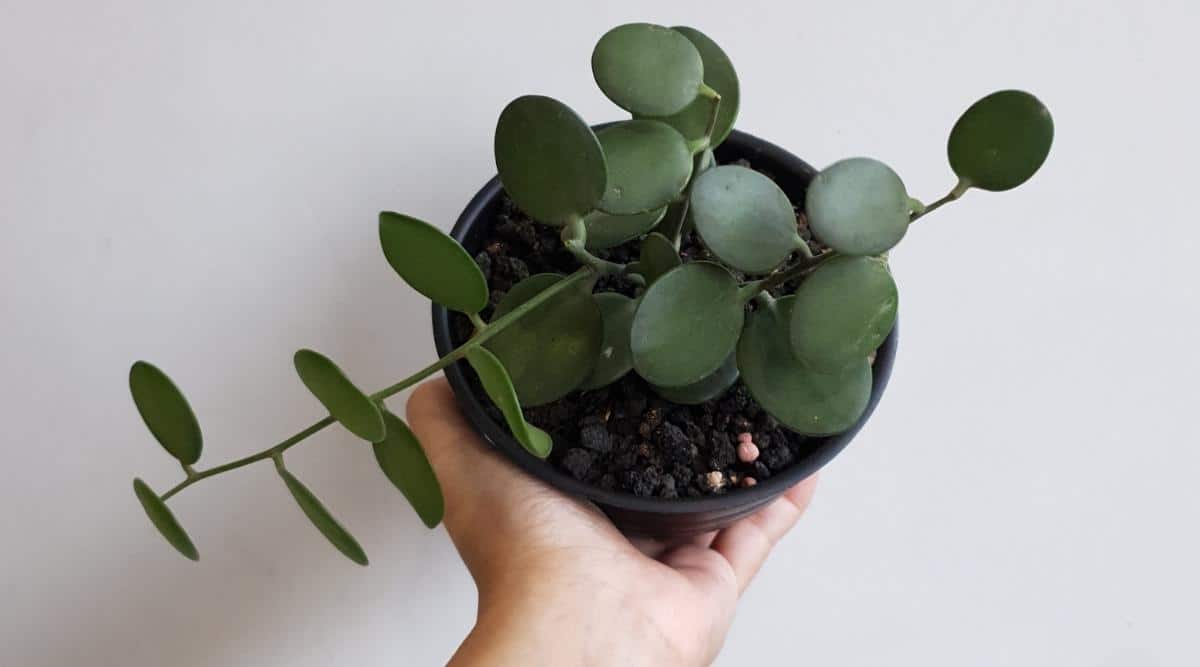
Scientific Name: Xerosicyos danguyi
- Plant Type: Perennial
- Size: 1-4 feet
- Watering Needs: When the top 1-2 inches of soil are dry
- Sun Exposure: Full sun to partial sun
The silver dollar plant enjoys popularity for its ease of maintenance. Its nickname stems from the perfectly round, fleshy leaves that stand out among other plant varieties.
Delicate branches emphasize the coin-shaped leaves, contributing to its delicate appearance. While appearing fragile, it can withstand suboptimal conditions and temperatures, making it a favored choice for indoor settings.
Starfish Plant
